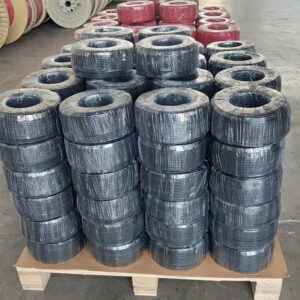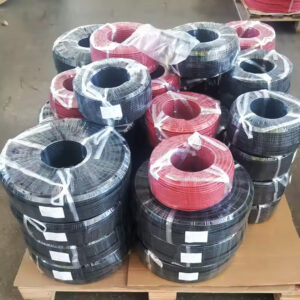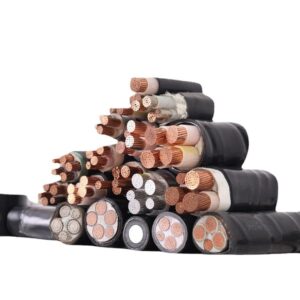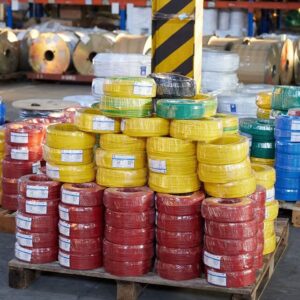1. Material Composition and Structural Design
Solar Cable (PV Cable)
Conductor:
1.Oxygen-Free Copper (OFC): ≥99.99% purity, minimizing resistance and electron scattering. Cross-sectional areas (e.g., 4mm², 6mm²) are optimized for DC current flow, reducing energy loss to <1% over long distances.
2.Tinning Option: Some PV cables feature tin-plated copper to prevent oxidation in humid environments.
Insulation:
1.Inner Layer: Cross-linked polyolefin (XLPO), a thermoset material resistant to cracking at high temperatures (up to 120°C).
2.Outer Layer: High-density polyethylene (HDPE) or LSZH (Low Smoke Zero Halogen), providing mechanical protection against abrasion and UV degradation.
Sheath:
1.LSZH Material: Halogen-free, emitting minimal smoke and no toxic gases (e.g., dioxins) during combustion. Passes IEC 60754-1/2 for gas toxicity testing.
Normal Cable (e.g., PVC Cable)
Conductor:
Annealed Copper or Aluminum: Lower purity (≤99.9%), higher resistance, prone to oxidation and voltage drop over time.
Insulation:
1.PVC (Polyvinyl Chloride): Thermoplastic material that softens at 70°C, leading to deformation and short circuits in high-heat environments.
2.Rubber: Degrades under UV exposure, becoming brittle and cracked within months outdoors.
Sheath:
PVC or Non-FR Materials: Releases thick black smoke and hydrochloric acid (HCl) when burned, posing fire hazards and health risks.

2. Performance Metrics
| Property | Solar Cable | Normal Cable |
|---|---|---|
| Voltage Rating | 1,000–1,500V DC (optimized for photovoltaic DC systems) | 300–600V AC (unsuitable for high DC voltage, leading to insulation breakdown) |
| Temperature Range | Operational: -40°C to +120°C Short Circuit: Withstands 250°C for 5s | Operational: -10°C to +70°C Failure Risk: Melts at >90°C |
| UV Resistance | Passes 3,000+ hours of QUV Accelerated Weathering Test (ASTM G154) | Fails within 500 hours; outer sheath cracks, exposing conductors |
| Bending Radius | Flexible design with ≥4x diameter bending radius (e.g., 40mm for 10mm² cable) | Stiff insulation cracks if bent beyond 6x diameter |
| Flame Resistance | Self-extinguishing (IEC 60332-1), prevents fire spread | Propagates flames (PVC drips ignite nearby materials) |
3. Application-Specific Requirements
Solar Energy Systems
High DC Voltage: PV systems operate at 600–1,500V DC. Normal cables lack insulation thickness (e.g., 0.6mm vs. 1.5mm for PV cables), risking arcing and fires.
Outdoor Exposure:
Desert Installations: PV cables resist sand abrasion and 24/7 UV radiation.
Coastal Areas: LSZH sheath prevents saltwater corrosion and fungal growth.
Roof Safety: Flame-retardant PV cables comply with building codes (e.g., NEC 690 in the U.S.), while PVC cables violate fire safety standards.
Normal Cable Use Cases
Indoor Wiring:Low-voltage AC applications (e.g., household appliances, lighting).
Short-Term Projects: Temporary installations where longevity and efficiency are irrelevant.

4. Certifications and Compliance
Mandatory for Solar Cables
TUV Rheinland: Tests for UV resistance, thermal cycling, and DC durability (IEC 62930).
UL 4703: North American standard for photovoltaic wire, ensuring fire safety and mechanical strength.
RoHS/REACH: Guarantees no hazardous substances (e.g., lead, phthalates).
Normal Cable Limitations
Generic Certifications: CE or RoHS marks do NOT cover PV-specific requirements.
Legal Risks: Using uncertified cables in solar projects may void insurance and breach local regulations (e.g., NEC 690.31).
5.ost-Benefit Analysis
| Factor | Solar Cable | Normal Cable |
|---|---|---|
| Initial Cost | $0.50–$1.50/meter (higher due to materials) | $0.20–$0.80/meter (cheap but risky) |
| Lifespan | 25–30 years (maintenance-free) | 3–8 years (frequent replacements required) |
| Energy Loss | ≤1% power loss over 100m | 3–5% loss due to higher resistance |
| System Downtime | Near-zero (designed for harsh conditions) | High (failures during extreme weather) |
| Environmental Impact | LSZH is recyclable and non-toxic | PVC releases carcinogens when landfilled |
6. How to Choose the Right Solar Cable
Match Voltage: Ensure the cable’s DC rating exceeds the system’s maximum voltage (e.g., 1,500V for utility-scale projects).
Check Certifications: Demand TUV/UL marks and test reports for UV/thermal cycling.
Customization: Opt for pre-terminated cables with MC4 connectors to reduce installation errors.
Supplier Audit: Verify factory ISO 9001 certification and batch testing protocols.
7.Conclusion
Solar cables are non-negotiable for photovoltaic systems. While normal cables might seem cost-effective initially, they jeopardize safety, efficiency, and compliance. Investing in certified PV cables ensures:
✅ 25+ years of reliable performance
✅ Reduced fire and liability risks
✅ Optimized energy output and ROI
Always prioritize quality over short-term savings-your solar project’s success depends on it.







